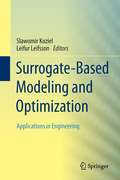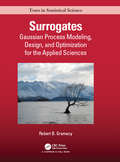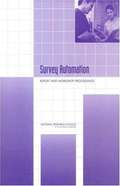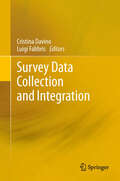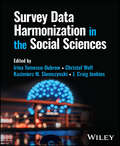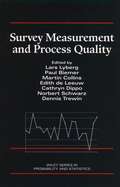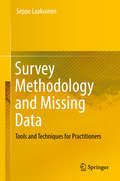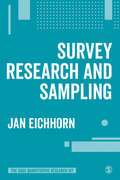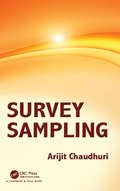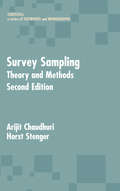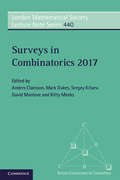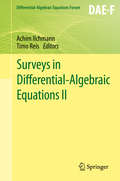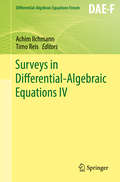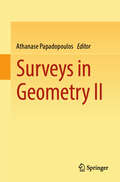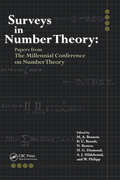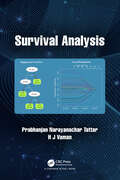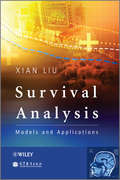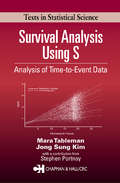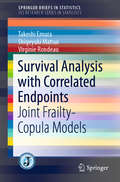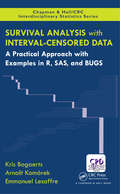- Table View
- List View
Surrogate-Based Modeling and Optimization
by Leifur Leifsson Slawomir KozielContemporary engineering design is heavily based on computer simulations. Accurate, high-fidelity simulations are used not only for design verification but, even more importantly, to adjust parameters of the system to have it meet given performance requirements. Unfortunately, accurate simulations are often computationally very expensive with evaluation times as long as hours or even days per design, making design automation using conventional methods impractical. These and other problems can be alleviated by the development and employment of so-called surrogates that reliably represent the expensive, simulation-based model of the system or device of interest but they are much more reasonable and analytically tractable. This volume features surrogate-based modeling and optimization techniques, and their applications for solving difficult and computationally expensive engineering design problems. It begins by presenting the basic concepts and formulations of the surrogate-based modeling and optimization paradigm and then discusses relevant modeling techniques, optimization algorithms and design procedures, as well as state-of-the-art developments. The chapters are self-contained with basic concepts and formulations along with applications and examples. The book will be useful to researchers in engineering and mathematics, in particular those who employ computationally heavy simulations in their design work.
Surrogates: Gaussian Process Modeling, Design, and Optimization for the Applied Sciences (Chapman & Hall/CRC Texts in Statistical Science)
by Robert B. GramacyComputer simulation experiments are essential to modern scientific discovery, whether that be in physics, chemistry, biology, epidemiology, ecology, engineering, etc. Surrogates are meta-models of computer simulations, used to solve mathematical models that are too intricate to be worked by hand. Gaussian process (GP) regression is a supremely flexible tool for the analysis of computer simulation experiments. This book presents an applied introduction to GP regression for modelling and optimization of computer simulation experiments. Features: • Emphasis on methods, applications, and reproducibility. • R code is integrated throughout for application of the methods. • Includes more than 200 full colour figures. • Includes many exercises to supplement understanding, with separate solutions available from the author. • Supported by a website with full code available to reproduce all methods and examples. The book is primarily designed as a textbook for postgraduate students studying GP regression from mathematics, statistics, computer science, and engineering. Given the breadth of examples, it could also be used by researchers from these fields, as well as from economics, life science, social science, etc.
Survey Automation: Report and Workshop Proceedings
by Oversight Committee for the Workshop on Survey AutomationFor over 100 years, the evolution of modern survey methodology—using the theory of representative sampling to make interferences from a part of the population to the whole—has been paralleled by a drive toward automation, harnessing technology and computerization to make parts of the survey process easier, faster, and better. The availability of portable computers in the late 1980s ushered in computer-assisted personal interviewing (CAPI), in which interviewers administer a survey instrument to respondents using a computerized version of the questionnaire on a portable laptop computer. Computer assisted interviewing (CAI) methods have proven to be extremely useful and beneficial in survey administration. However, the practical problems encountered in documentation and testing CAI instruments suggest that this is an opportune time to reexamine not only the process of developing CAI instruments but also the future directions of survey automation writ large.
Survey Data Collection and Integration
by Cristina Davino Luigi FabbrisStatistical surveys represent an important source of scientific knowledge and a valid decision support tool in many fields, from social studies to economics, market research, health studies, and others. Scientists have tackled most of the methodological issues concerning surveys and the scientific literature offers excellent proposals for planning and conducting surveys. Nevertheless, surveys often require the achievement of aims that either deviate from the methodology or do not have a specific solution at all. This book focuses on survey theory and applications, providing insight and innovative solutions to face problems in data collection and integration, complex sample design, opinion questionnaire design, and statistical estimation. Formal rigour and simple language, together with real-life examples, will make the book suitable to both practitioners involved in applied research and to academics interested in scientific developments in the survey field.
Survey Data Harmonization in the Social Sciences
by J. Craig Jenkins Kazimierz M. Slomczynski Christof Wolf Irina Tomescu‐DubrowSurvey Data Harmonization in the Social Sciences An expansive and incisive overview of the practical uses of harmonization and its implications for data quality and costs In Survey Data Harmonization in the Social Sciences, a team of distinguished social science researchers delivers a comprehensive collection of ex-ante and ex-post harmonization methodologies in the context of specific longitudinal and cross-national survey projects. The book examines how ex-ante and ex-post harmonization work individually and in relation to one another, offering practical guidance on harmonization decisions in the preparation of new data infrastructure for comparative research. Contributions from experts in sociology, political science, demography, economics, health, and medicine are included, all of which give voice to discipline-specific and interdisciplinary views on methodological challenges inherent in harmonization. The authors offer perspectives from Europe and the United States, as well as Africa, the latter of which provides insights rarely featured in survey research methodology handbooks. Readers will also find: A thorough introduction to approaches and concepts for survey data harmonization, as well as the effects of data harmonization on the overall survey research process Comprehensive explorations of ex-ante harmonization of survey instruments and non-survey data Practical discussions of ex-post harmonization of national social surveys, census and time use data, including explorations of survey data recycling A detailed overview of statistical issues linked to the use of harmonized survey data Perfect for upper undergraduate and graduate researchers who specialize in survey methodology, Survey Data Harmonization in the Social Sciences will also earn a place in the libraries of survey practitioners who engage in international research.
Survey Measurement and Process Quality
by Martin Collins Lars Lyberg Paul Biemer Edith De Leeuw Cathryn Dippo Norbert Schwarz Dennis TrewinAn in-depth look at current issues, new research findings, and interdisciplinary exchange in survey methodology and processing Survey Measurement and Process Quality extends the marriage of traditional survey issues and continuous quality improvement further than any other contemporary volume. It documents the current state of the field, reports new research findings, and promotes interdisciplinary exchange in questionnaire design, data collection, data processing, quality assessment, and effects of errors on estimation and analysis. The book's five sections discuss a broad range of issues and topics in each of five major areas, including * Questionnaire design--conceptualization, design of rating scales for effective measurement, self-administered questionnaires, and more * Data collection--new technology, interviewer effects, interview mode, children as respondents * Post-survey processing and operations--modeling of classification operations, coding based on such systems, editing, integrating processes * Quality assessment and control--total quality management, developing current best methods, service quality, quality efforts across organizations * Effects of misclassification on estimation, analysis, and interpretation--misclassification and other measurement errors, new variance estimators that account for measurement error, estimators of nonsampling error components in interview surveys Survey Measurement and Process Quality is an indispensable resource for survey practitioners and managers as well as an excellent supplemental text for undergraduate and graduate courses and special seminars.
Survey Methodology
by Floyd J. Fowler Jr. Eleanor Singer James M. Lepkowski Roger Tourangeau Robert M. Groves Mick P. CouperThis new edition of Survey Methodology continues to provide a state-of-the-science presentation of essential survey methodology topics and techniques. The volume's six world-renowned authors have updated this Second Edition to present newly emerging approaches to survey research and provide more comprehensive coverage of the major considerations in designing and conducting a sample survey.Key topics in survey methodology are clearly explained in the book's chapters, with coverage including sampling frame evaluation, sample design, development of questionnaires, evaluation of questions, alternative modes of data collection, interviewing, nonresponse, post-collection processing of survey data, and practices for maintaining scientific integrity. Acknowledging the growing advances in research and technology, the Second Edition features: Updated explanations of sampling frame issues for mobile telephone and web surveys. New scientific insight on the relationship between nonresponse rates and nonresponse errors. Restructured discussion of ethical issues in survey research, emphasizing the growing research results on privacy, informed consent, and confidentiality issues. The latest research findings on effective questionnaire development techniques. The addition of 50% more exercises at the end of each chapter, illustrating basic principles of survey design. An expanded FAQ chapter that addresses the concerns that accompany newly established methods. Providing valuable and informative perspectives on the most modern methods in the field, Survey Methodology, Second Edition is an ideal book for survey research courses at the upper-undergraduate and graduate levels. It is also an indispensable reference for practicing survey methodologists and any professional who employs survey research methods.
Survey Methodology and Missing Data: Tools and Techniques for Practitioners
by Seppo LaaksonenThis book focuses on quantitative survey methodology, data collection and cleaning methods. Providing starting tools for using and analyzing a file once a survey has been conducted, it addresses fields as diverse as advanced weighting, editing, and imputation, which are not well-covered in corresponding survey books. Moreover, it presents numerous empirical examples from the author's extensive research experience, particularly real data sets from multinational surveys.
Survey Research and Sampling (The SAGE Quantitative Research Kit)
by Jan EichhornThis book is an ideal companion for students looking to undertake survey research. Anchored by lots of case studies of real research and expert interviews to strengthen your understanding, it provides guidance on: Selecting the best sampling method for your research Designing questionnaires to ensure you gather valuable data Collecting your data to represent populations well Piloting questionnaires to ensure quality research Part of The SAGE Quantitative Research Kit, this book will give you the know-how and confidence needed to succeed on your quantitative research journey
Survey Research and Sampling (The SAGE Quantitative Research Kit)
by Jan EichhornThis book is an ideal companion for students looking to undertake survey research. Anchored by lots of case studies of real research and expert interviews to strengthen your understanding, it provides guidance on: Selecting the best sampling method for your research Designing questionnaires to ensure you gather valuable data Collecting your data to represent populations well Piloting questionnaires to ensure quality research Part of The SAGE Quantitative Research Kit, this book will give you the know-how and confidence needed to succeed on your quantitative research journey
Survey Sampling: Theory And Methods, Second Edition (Statistics: A Series Of Textbooks And Monographs #Vol. 171)
by Arijit ChaudhuriThis venture aspires to be a mix of a textbook at the undergraduate and postgraduate levels and a monograph to catch the attention of researchers in theoretical and practical aspects of survey sampling at diverse levels demanding a comprehensive review of what useful materials have preceded, with an eye to what beacons to the depth of the imminent future.
Survey Sampling: Theory and Methods, Second Edition (Statistics: A Series of Textbooks and Monographs)
by Arijit Chaudhuri Horst StengerSince publication of the first edition in 1992, the field of survey sampling has grown considerably. This new edition of Survey Sampling: Theory and Methods has been updated to include the latest research and the newest methods. The authors have undertaken the daunting task of surveying the sampling literature of the past decade to provide an outst
Surveys in Combinatorics 2013
by Simon R. Blackburn Stefanie Gerke Mark WildonThis volume contains nine survey articles based on the invited lectures given at the 24th British Combinatorial Conference, held at Royal Holloway, University of London in July 2013. This biennial conference is a well-established international event, with speakers from around the world. The volume provides an up-to-date overview of current research in several areas of combinatorics, including graph theory, matroid theory and automatic counting, as well as connections to coding theory and Bent functions. Each article is clearly written and assumes little prior knowledge on the part of the reader. The authors are some of the world's foremost researchers in their fields, and here they summarise existing results and give a unique preview of cutting-edge developments. The book provides a valuable survey of the present state of knowledge in combinatorics, and will be useful to researchers and advanced graduate students, primarily in mathematics but also in computer science and statistics.
Surveys in Combinatorics 2015
by Artur Czumaj Agelos Georgakopoulos Daniel Král' Vadim Lozin Oleg PikhurkoThis volume contains nine survey articles based on the invited lectures given at the 25th British Combinatorial Conference, held at the University of Warwick in July 2015. This biennial conference is a well-established international event, with speakers from around the world. The volume provides an up-to-date overview of current research in several areas of combinatorics, including graph theory, Ramsey theory, combinatorial geometry and curves over finite fields. Each article is clearly written and assumes little prior knowledge on the part of the reader. The authors are some of the world's foremost researchers in their fields, and here they summarise existing results and give a unique preview of cutting-edge developments. The book provides a valuable survey of the present state of knowledge in combinatorics, and will be useful to researchers and advanced graduate students, primarily in mathematics but also in computer science and statistics.
Surveys in Combinatorics 2017 (London Mathematical Society Lecture Note Series #440)
by Anders Claesson Mark Dukes Sergey Kitaev David Manlove Kitty MeeksThis volume contains nine survey articles which provide expanded accounts of plenary seminars given at the British Combinatorial Conference at the University of Strathclyde in July 2017. This biennial conference is a well-established international event attracting speakers from around the world. Written by internationally recognised experts in the field, these articles represent a timely snapshot of the state of the art in the different areas of combinatorics. Topics covered include the robustness of graph properties, the spt-function of Andrews, switching techniques for edge decompositions of graphs, monotone cellular automata, and applications of relative entropy in additive combinatorics. The book will be useful to researchers and advanced graduate students, primarily in mathematics but also in computer science and statistics.
Surveys in Differential-Algebraic Equations I
by Achim Ilchmann Timo ReisThe need for a rigorous mathematical theory for Differential-Algebraic Equations (DAEs) has its roots in the widespread applications of controlled dynamical systems, especially in mechanical and electrical engineering. Due to the strong relation to (ordinary) differential equations, the literature for DAEs mainly started out from introductory textbooks. As such, the present monograph is new in the sense that it comprises survey articles on various fields of DAEs, providing reviews, presentations of the current state of research and new concepts in - Controllability for linear DAEs - Port-Hamiltonian differential-algebraic systems - Robustness of DAEs - Solution concepts for DAEs - DAEs in circuit modeling. The results in the individual chapters are presented in an accessible style, making this book suitable not only for active researchers but also for graduate students (with a good knowledge of the basic principles of DAEs) for self-study.
Surveys in Differential-Algebraic Equations IV
by Achim Ilchmann Timo ReisThe present volume comprises survey articles on various fields of Differential-Algebraic Equations (DAEs) which have widespread applications in controlled dynamical systems, especially in mechanical and electrical engineering and a strong relation to (ordinary) differential equations. The individual chapters provide reviews, presentations of the current state of research and new concepts in - History of DAEs - DAE modelling of mechanical multibody systems - Model reduction of DAEs - Observability for DAEs - Numerical Analysis for DAEs The results are presented in an accessible style, making this book suitable not only for active researchers but also for graduate students (with a good knowledge of the basic principles of DAEs) for self-study.
Surveys in Geometry I
by Athanase PapadopoulosThe volume consists of a set of surveys on geometry in the broad sense. The goal is to present a certain number of research topics in a non-technical and appealing manner.The topics surveyed include spherical geometry, the geometry of finite-dimensional normed spaces, metric geometry (Bishop—Gromov type inequalities in Gromov-hyperbolic spaces), convexity theory and inequalities involving volumes and mixed volumes of convex bodies, 4-dimensional topology, Teichmüller spaces and mapping class groups actions, translation surfaces and their dynamics, and complex higher-dimensional geometry.Several chapters are based on lectures given by their authors to middle-advanced level students and young researchers. The whole book is intended to be an introduction to current research trends in geometry.
Surveys in Geometry II
by Athanase PapadopoulosThe book is the second volume of a collection which consists of surveys that focus on important topics in geometry which are at the heart of current research. The topics in the present volume include the conformal and the metric geometry of surfaces, Teichmüller spaces, immersed surfaces of prescribed extrinsic curvature in 3-dimensional manifolds, symplectic geometry, the metric theory of Grassmann spaces, homogeneous metric spaces, polytopes, the higher-dimensional Gauss–Bonnet formula, isoperimetry in finitely generated groups and Coxeter groups.Each chapter is intended for graduate students and researchers. Several chapters are based on lectures given by their authors to middle-advanced level students and young researchers. The whole book is intended to be an introduction to important topics in geometry.
Surveys in Number Theory: Papers from the Millennial Conference on Number Theory
by M. A. Bennett N. Boston H. G. Diamond A. J. Hildebrand B. C. Berndt W PhilippThis volume, based on fourteen papers from the Millennial Conference on Number Theory, represents surveys of topics in number theory and provides an outlook into the future of number theory research. It serves as an inspiration to graduate students and as a reference for research mathematicians.
Survival Analysis
by Prabhanjan Tattar H J VamanSurvival analysis generally deals with analysis of data arising from clinical trials. Censoring, truncation, and missing data create analytical challenges and the statistical methods and inference require novel and different approaches for analysis. Statistical properties, essentially asymptotic ones, of the estimators and tests are aptly handled in the counting process framework which is drawn from the larger arm of stochastic calculus. With explosion of data generation during the past two decades, survival data has also enlarged assuming a gigantic size. Most statistical methods developed before the millennium were based on a linear approach even in the face of complex nature of survival data. Nonparametric nonlinear methods are best envisaged in the Machine Learning school. This book attempts to cover all these aspects in a concise way. Survival Analysis offers an integrated blend of statistical methods and machine learning useful in analysis of survival data. The purpose of the offering is to give an exposure to the machine learning trends for lifetime data analysis. Features: Classical survival analysis techniques for estimating statistical functional and hypotheses testing Regression methods covering the popular Cox relative risk regression model, Aalen’s additive hazards model, etc. Information criteria to facilitate model selection including Akaike, Bayes, and Focused Penalized methods Survival trees and ensemble techniques of bagging, boosting, and random survival forests A brief exposure of neural networks for survival data R program illustration throughout the book
Survival Analysis
by Xian LiuSurvival analysis concerns sequential occurrences of events governed by probabilistic laws. Recent decades have witnessed many applications of survival analysis in various disciplines. This book introduces both classic survival models and theories along with newly developed techniques. Readers will learn how to perform analysis of survival data by following numerous empirical illustrations in SAS.Survival Analysis: Models and Applications: Presents basic techniques before leading onto some of the most advanced topics in survival analysis.Assumes only a minimal knowledge of SAS whilst enabling more experienced users to learn new techniques of data input and manipulation.Provides numerous examples of SAS code to illustrate each of the methods, along with step-by-step instructions to perform each technique.Highlights the strengths and limitations of each technique covered.Covering a wide scope of survival techniques and methods, from the introductory to the advanced, this book can be used as a useful reference book for planners, researchers, and professors who are working in settings involving various lifetime events. Scientists interested in survival analysis should find it a useful guidebook for the incorporation of survival data and methods into their projects.
Survival Analysis Using S: Analysis of Time-to-Event Data (Chapman & Hall/CRC Texts in Statistical Science)
by Mara Tableman Jong Sung KimSurvival Analysis Using S: Analysis of Time-to-Event Data is designed as a text for a one-semester or one-quarter course in survival analysis for upper-level or graduate students in statistics, biostatistics, and epidemiology. Prerequisites are a standard pre-calculus first course in probability and statistics, and a course in applied linear regres
Survival Analysis with Correlated Endpoints: Copula-based Approaches (SpringerBriefs in Statistics)
by Shigeyuki Matsui Takeshi Emura Virginie RondeauThis book introduces readers to advanced statistical methods for analyzing survival data involving correlated endpoints. In particular, it describes statistical methods for applying Cox regression to two correlated endpoints by accounting for dependence between the endpoints with the aid of copulas. The practical advantages of employing copula-based models in medical research are explained on the basis of case studies. <P><P> In addition, the book focuses on clustered survival data, especially data arising from meta-analysis and multicenter analysis. Consequently, the statistical approaches presented here employ a frailty term for heterogeneity modeling. This brings the joint frailty-copula model, which incorporates a frailty term and a copula, into a statistical model. The book also discusses advanced techniques for dealing with high-dimensional gene expressions and developing personalized dynamic prediction tools under the joint frailty-copula model. <P><P> To help readers apply the statistical methods to real-world data, the book provides case studies using the authors’ original R software package (freely available in CRAN). The emphasis is on clinical survival data, involving time-to-tumor progression and overall survival, collected on cancer patients. Hence, the book offers an essential reference guide for medical statisticians and provides researchers with advanced, innovative statistical tools. The book also provides a concise introduction to basic multivariate survival models.
Survival Analysis with Interval-Censored Data: A Practical Approach with Examples in R, SAS, and BUGS (Chapman & Hall/CRC Interdisciplinary Statistics)
by Emmanuel Lesaffre Kris Bogaerts Arnost KomarekSurvival Analysis with Interval-Censored Data: A Practical Approach with Examples in R, SAS, and BUGS provides the reader with a practical introduction into the analysis of interval-censored survival times. Although many theoretical developments have appeared in the last fifty years, interval censoring is often ignored in practice. Many are unaware of the impact of inappropriately dealing with interval censoring. In addition, the necessary software is at times difficult to trace. This book fills in the gap between theory and practice. Features: -Provides an overview of frequentist as well as Bayesian methods. -Include a focus on practical aspects and applications. -Extensively illustrates the methods with examples using R, SAS, and BUGS. Full programs are available on a supplementary website. The authors: Kris Bogaerts is project manager at I-BioStat, KU Leuven. He received his PhD in science (statistics) at KU Leuven on the analysis of interval-censored data. He has gained expertise in a great variety of statistical topics with a focus on the design and analysis of clinical trials. Arnošt Komárek is associate professor of statistics at Charles University, Prague. His subject area of expertise covers mainly survival analysis with the emphasis on interval-censored data and classification based on longitudinal data. He is past chair of the Statistical Modelling Society and editor of Statistical Modelling: An International Journal. Emmanuel Lesaffre is professor of biostatistics at I-BioStat, KU Leuven. His research interests include Bayesian methods, longitudinal data analysis, statistical modelling, analysis of dental data, interval-censored data, misclassification issues, and clinical trials. He is the founding chair of the Statistical Modelling Society, past-president of the International Society for Clinical Biostatistics, and fellow of ISI and ASA.
